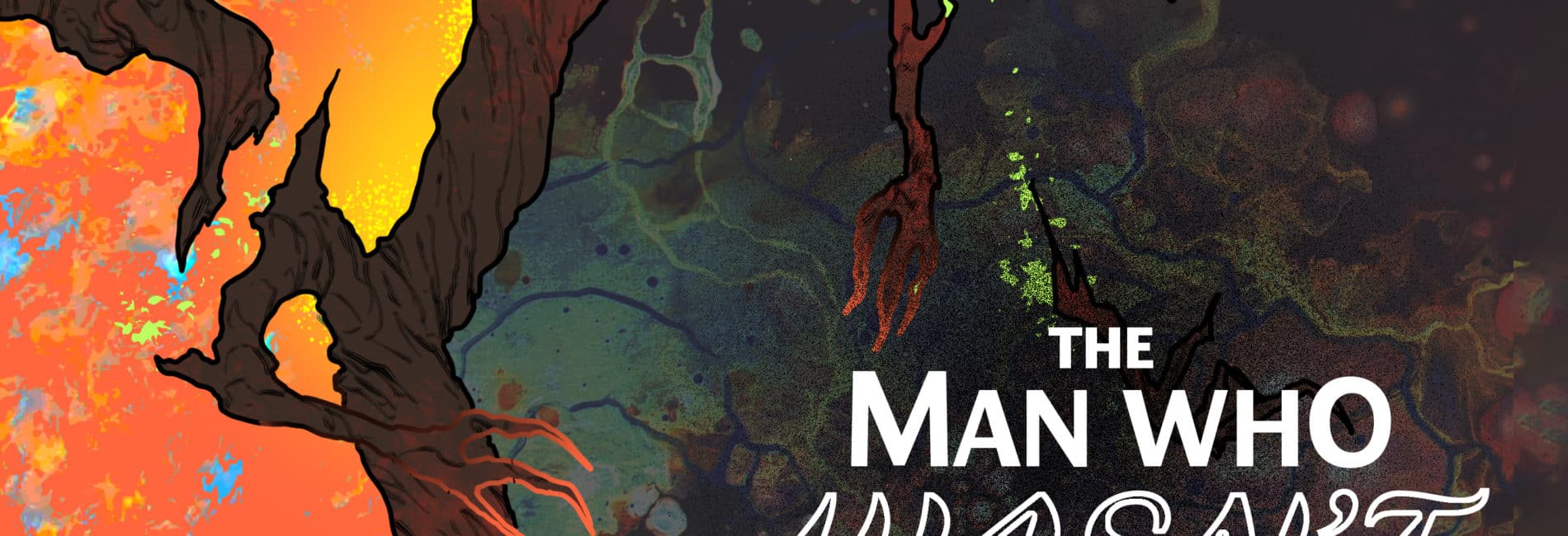Interview with writer and creator Michael Lent
By: Sheena C. Howard, 10-23-2020
1. Can you tell us about your new interactive comic book on GlobalComix.com?
Hi, Sheena! First off, thanks very much for having me. I’ve read your wonderful novel Nina’s Whisper, as well as quite a bit of the Encyclopedia of Black Comics and Black Comics: Politics of Race and Representation, which is an important contribution for our medium that I’m glad that the Eisner Awards recognized. Its an honor to discuss with you The Man Who Wasn’t There.
So The Man Who Wasn’t There is a single issue “one-off” historical horror story that’s a new way into “Antigonish,” probably the world’s most famous gothic poem written in 1899 by William “Hughes” Mearns. Mearns is a noted educator and poet often credited for coining the term “creative writing.” Hardly anyone recognizes that Antigonish title anymore but everyone seems to know the actual poem which starts with one of the most famous horror stanzas in poetry:
Yesterday, upon the stair,
I met a man who wasn’t there.
He wasn’t there again today.
I wish, I wish he’d go away.
The poem was inspired by a late-19th century news story about a “ghost man” who reportedly haunted a house in Antigonish, Nova Scotia in Canada. Supposedly, dozens of people saw this ghost at the time. “Antigonish” is most often interpreted and adapted as an atmospheric but straight-forward scary story about someone who is haunted by an apparition in a house. However, as with all good literature, the poem has multiple levels of meaning that warrant further investigation. As a matter of fact, in “Pick Up Your Heart,” Lil Wayne sampled it to discuss a relationship between a man and woman.
As a fellow writer, you may relate to the desire to find an appropriate story to convey thoughts and feelings you may have versus simply proclaiming them on Reddit or Facebook. I would rather show than tell. One of the first gigs I had after graduate school was teaching creative writing at the California Institute for Men, aka the Chino Men’s Prison. The place is like a small city with over 3,000 people warehoused in the desert. I used to make the 60 mile drive from LA twice a week and the amount of squandered human potential was disheartening and sometimes it hit me hard and I had to collect myself in my car before making that drive home. One of my best students had been in a biker gang since the age of 14 and when he mentioned “knowing where the bodies are buried,” I was pretty sure that it wasn’t a turn of phrase and that he, like most of my students, would not be down for a standard lecture about Strunk and White elements of style. I assume that most people feel that way after what has been going on the past four years, the last seven months, in particular. So for me and the artists I collaborated with, Evaradi (panelist) and Marc Rene (cover), the “Antigonish” poem is a recognizable but fresh way into expressing some of the physical and psychological horrors many of us are experiencing in our society right now. For example, how do you confront something that is and isn’t there? Or something seen and felt by you but denied by others? I think these are similar themes to what is in Get Out, Lovecraft Country and Watchmen.
Of course, if you just want to experience a scary story about a young man trying to traverse a nightmare landscape who seeks refuge in a haunted house, that’s there, too. My kids have looked over my shoulder many times and what they mostly see is a hyper-scary ghost story.
2. It sounds like a passion project.
Yes, it is. On March 22nd, 2018, I saw the story of Stephon Clark who was shot and killed by Sacramento police while talking on a cellphone in his grandmother’s backyard on a Sunday night. I immediately thought of the “Antigonish” poem — the visceral horror and psychophrenia of that all-to-common incident — and started adapting the work that same night.
Mostly, the writing and art came together at midnight and 4:00 a.m. when everything else in life and work had been squared away.
3. How would you best describe the work and what it means to you?
To us, The Man Who Wasn’t There is an opportunity to join the conversation and find a creative way to express the trauma many of us feel right now.
As a transmedia writer/producer of movies, comics and books, when people know me, it is usually for the horror genre. Artist Marc Rene and I have collaborated together on four graphic novels and comics since 2012 including The Machine Stops and i, Holmes. Marc is intensely gifted and it pains me to hear and see some of the things he has experienced as a man of color in America. So I’m gratified whenever we can work together and make our voices heard with a project like The Man Who Wasn’t There.
For the past few years in particular, I’ve felt distressed by what’s going on in the world and while it’s not practical for me as a dad with three kids, a mother-in-law that lives with us, and two dogs to be out protesting every week, I can create and contribute to the discussion. To that end, a small team of us worked on this book for more than two years and then decided that with everything that people are going through right now, we would make the book available for free if we could.
4. Who else was involved in bringing this creative work to fruition? Can you tell us a bit about your creative team?
The underlying poem I adapted, “Antigonish”, is by Hughes Mearns who was also an educator, a proponent of progressive education, particularly by encouraging the natural creativity of young children. In the early 20th century, kids were thought of as mainly property, so seeing them as individuals with complex emotions and fostering their ability to express them was a novel concept.
The Man Who Wasn’t There panel art, color and lettering are by Evaradi (Evaristus Anarado) who is based in Awka, Nigeria. Originally, I envisioned a certain loose and organic style for the art. As often happens with these kind of independent projects, you have some false starts at various stages. Understanding the vision is the first obstacle and creating on deadline is the second. I wrote the script fairly quickly — it was coming out of my brain like a firehose at certain points — but then the art side stalled out. I got lucky when I saw Evaradi’s art on a posting board and responded to his beautiful, dreamlike images. He has an outsider’s perspective of American history and his art really holds the reader’s gaze.
As for the material, Evaradi got it at a gut level. Based in Nigeria, sometimes he would race across town in a bus or taxi to avoid a power outage or police curfew so that he could keep drawing late into the night. Once, we skyped to discuss some panels and I saw that his space was lit by a single naked bulb in the center of the room.
Marc Rene is our cover artist. As mentioned, we’ve worked together for eight years. Hard to believe, Marc is self-taught with a background in design. His credits include work for Cartoon Network, Disney, and Creative Juices Design. The thing to know about Marc is that he is a former college debate champion so the chances of winning any argument are slim. Luckily, we are usually on the same page creatively. I should also mention that Marc has a 6-year old daughter who is about the cutest little girl on the planet.
Interior Formatting & Design by Tella Opeyemi John of Emphaloz Digital also of Nigeria. Opeyemi has guided books & products to Amazon Best Seller status, so we felt fortunate to have his assistance.
5. Who or what has been an inspiration or influence for this project?
I read a lot of Neil Gaiman and I hope some of that magic rubs off. Also, early on when I was starting this project I was asked to speak at a comic-con in Richmond. While there, my in-laws who live in Virginia brought me to the Edgar Allan Poe Museum. The architecture of Richmond and Poe’s work were definitely influences. In fact, my in-laws bought me a cool Poe mug to inspire each writing session.
6. What is your ultimate goal for The Man Who Wasn’t There?
There is so much raw emotion out there that we hoped to express and channel creatively and constructively. We hope readers hear us and in turn, feel heard. We know people are hurting. For this reason, we made the book available for free.
GlobalComix.com is a relatively new platform with a worldwide readership and the principals Chris Carter, Gamal Hennessy and Eric Tapper believed in what we were trying to accomplish and helped make it happen. I think we are close to 5,000 panel reads since August so readers seem to be responding to the interactive format and the work itself.
7. Where can people learn more about you and the other creators involved with this project?
People can read The Man Who Wasn’t There here and find my work at the usual places of Wikipedia, Amazon and IMDB.
—
Michael Lent can be found on Facebook and Twitter.
Marc Rene, artist and illustrator, can be found at marcreneonline.com.



